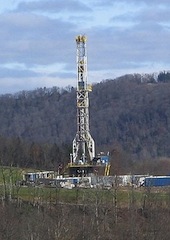U.S. Shale Gas: All It’s Cracked Up to Be?
The shale boom in the United States isn’t the game-changer its proponents claim.
October 21, 2013

In the eyes of its advocates, shale gas is a game changer. It will lead the U.S. economy to new heights, resuscitate U.S. manufacturing and bring many new jobs. It is also said to transform global energy relationships. But how is all that hype holding up? Which of the following statements about U.S. shale gas is true?
A. It will provide a strong boost to U.S. economic growth
B. Its benefits will last for many years
C. It will radically alter the global energy landscape
D. It will put other Western nations at a competitive disadvantage
A. It will provide a strong boost to U.S. economic growth: Not correct
According to a new analysis by the IMF, shale gas and tight oil (which is produced from shale, tar sands and other unconventional sources) will increase real GDP in the United States by only 1.2%. However, that is not an annual increase, as shale gas proponents would have one believe. Rather, this is expected total increase in growth at the end of 13 years.
In other words, shale gas is expected to increase the size of the U.S. economy by less than 0.1% a year over that time period. The main reason why the effect is so limited is that the share of the oil and gas sectors in the U.S. economy — at 1.5% of GDP — is quite limited to begin with.
B. Its benefits will last for many years: Not certain
On the one hand, it is generally assumed that U.S. shale gas production will increase steadily until 2040. On the other hand, the energy companies that made big investments in the shale gas sector now acknowledge that the activity is far less profitable than early backers assumed.
Shell, which made big bets on the Marcellus Shale formation and other fields in North America, wrote down the value of its shale gas investments by more than $2 billion in 2013.
The main reason for this is that shale gas production is actually quite inefficient. Newly established wells, after an initially burst of gas production, deplete very quickly.
The rapid dropoff means that the only way to keep up a high level of production is to constantly be setting up new wells. This in turn raises the producer’s costs and lowers overall profitability. Lower profit expectations make producers less likely to enter the sector — at least until new, less expensive extraction technology is developed.
C. It will radically alter the global energy landscape: Possible
The United States is expected to become a net exporter of natural gas in the 2020s — largely as a result of newly discovered shale gas deposits. However, it is unclear how profoundly shale gas will change the global energy landscape.
The U.S. State Department has been very active in trying to use shale gas as a tool to make sure that countries become less dependent on Russian gas. Via its Unconventional Gas Technical Engagement Program (UGTEP), the State Department has also been eager to use shale gas technology to form new alliances, including on the continent of Africa.
However, the general acceptance of shale gas drilling — especially among the European public, including in Eastern Europe — is much lower than it is in the United States. This is, in part, due to a higher awareness of environmental risks associated with the technology. In addition, due to Europe’s higher population density, there often aren’t the vast geographic expanses that can be found in the United States.
Unlike U.S. states, European governments are also committed to using a precautionary approach and do not give shale gas producers a carte blanche regarding the chemicals they use. They are more stringent regarding disclosures of the toxicity of the chemicals cocktail the industry uses to get to the unconventional gas.
D. It will put other Western nations at a competitive disadvantage: Not certain
The argument is often raised that Europe’s resistance to shale gas represents a severe disadvantage to those nations’ energy-intensive industries.
While Europe’s chemical and auto industries, for example, may be at a temporary disadvantage, they always have the option of moving production to the United States. Because these are very capital-intensive industries, the number of workers affected actually isn’t all that large. In addition, one of the effects of this shift would be for Europe to export pollution to the United States.
In addition, European industry is increasingly taking a decidedly different path from America’s — by focusing on post-fossil fuel solutions, rather than tying its fortunes ever closer to it, as is the case in the United States.
Takeaways
The U.S. shale oil and gas boom will not provide a strong boost to U.S. economic growth.
The benefits of the shale boom to the U.S. economy may not last for many years.
The shale boom in the U.S. may radically alter the global energy landscape but probably won't.
It is not certain the shale boom will give a competitive advantage to the U.S. over other Western nations.
Read previous

Carried Away by the Shale Gale
October 21, 2013
